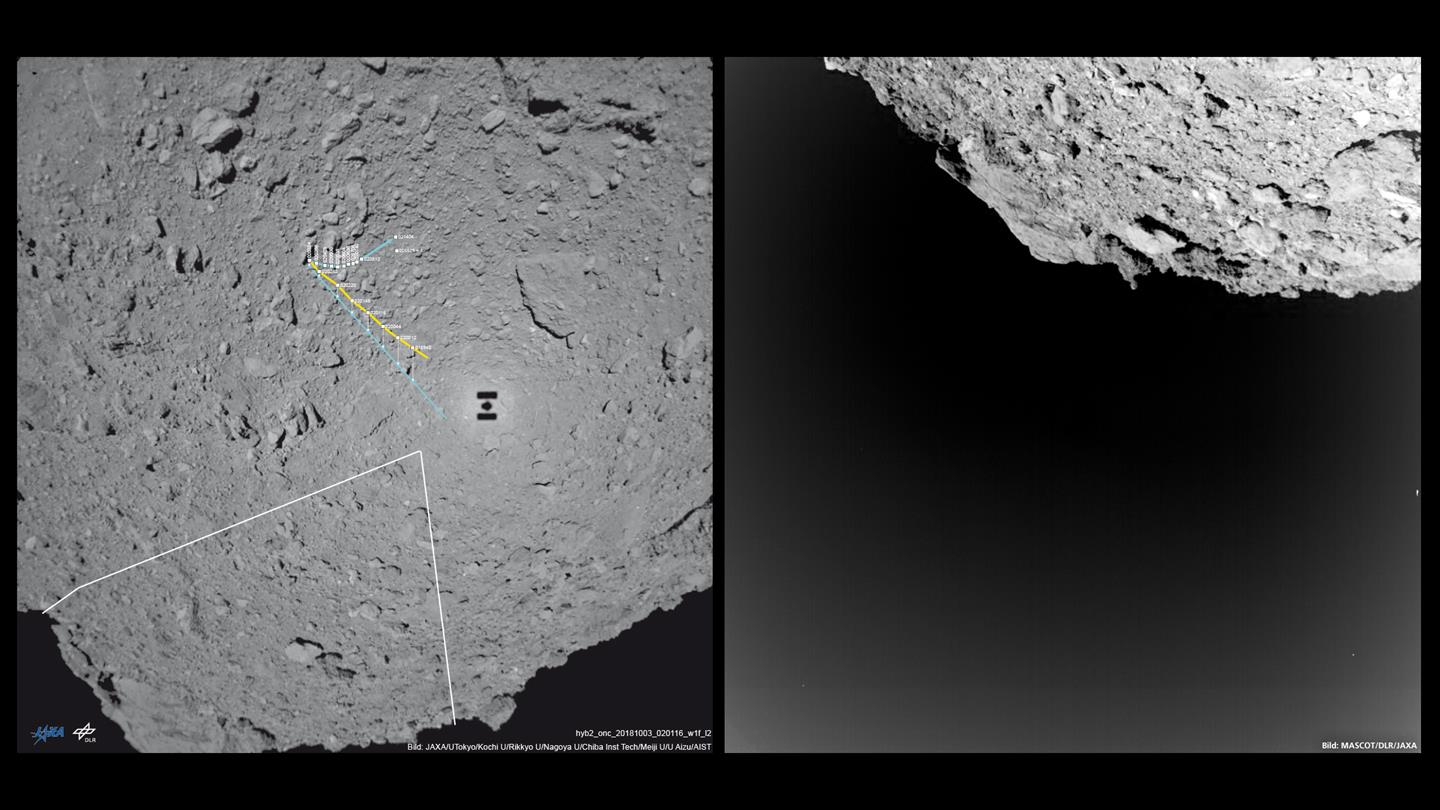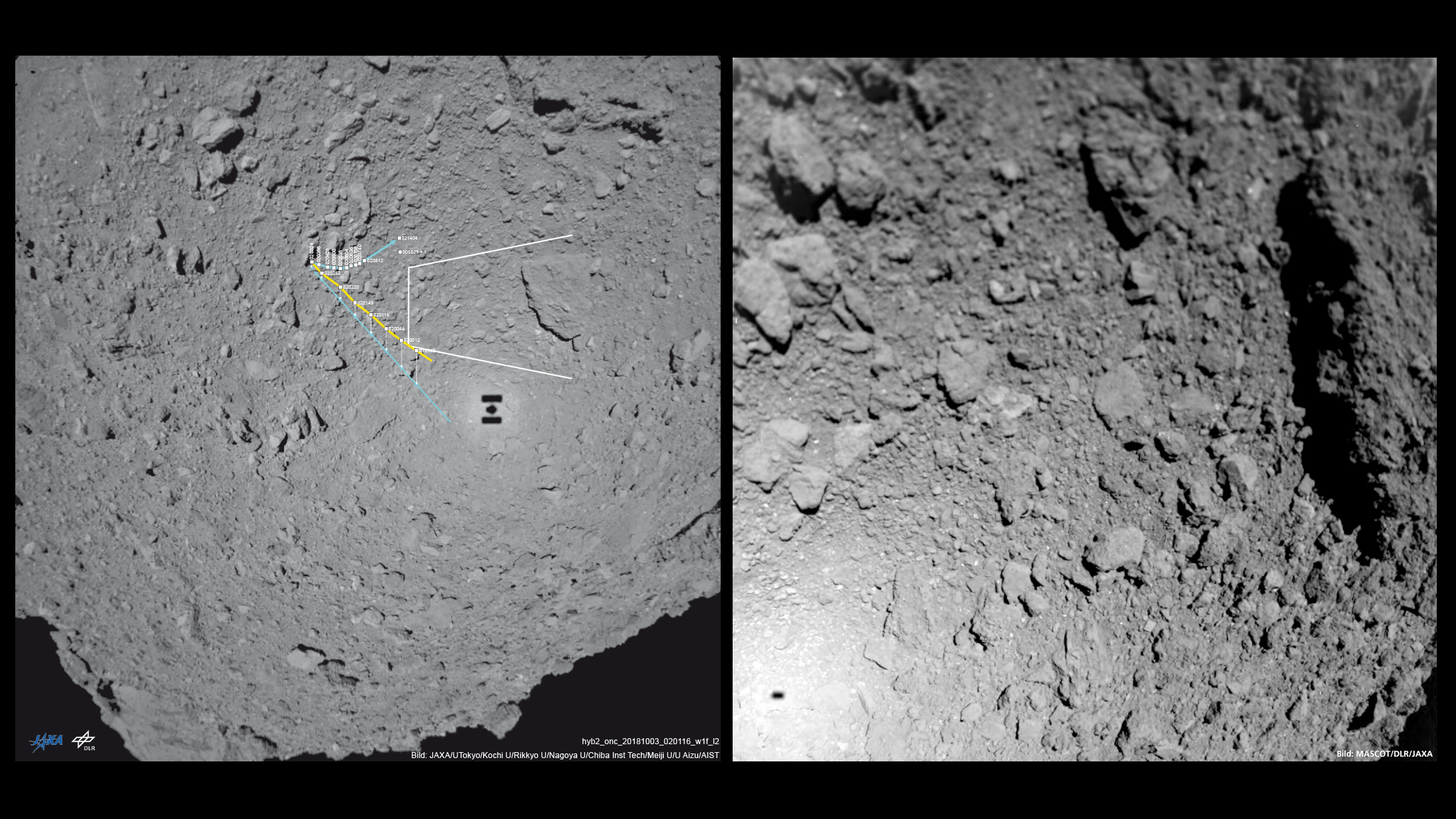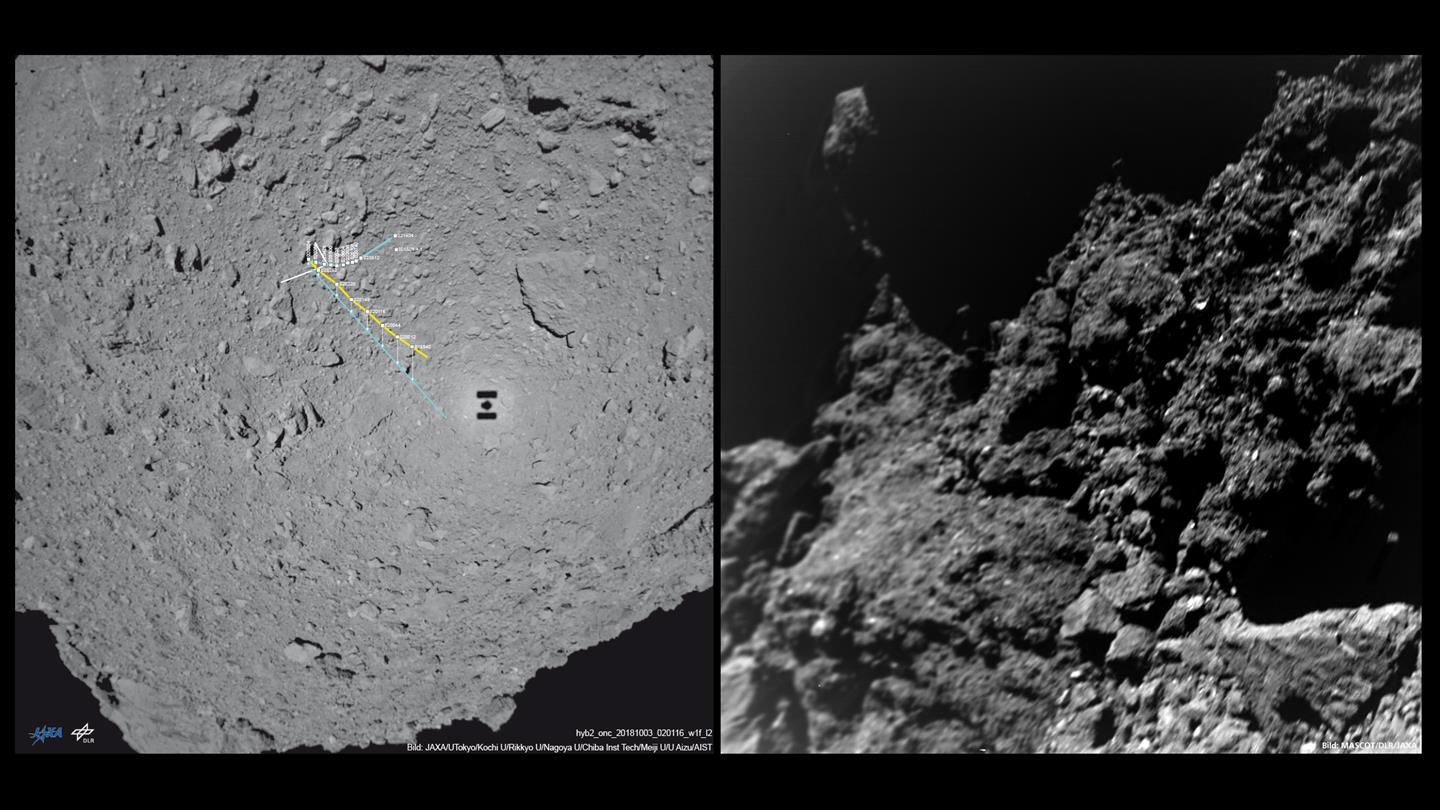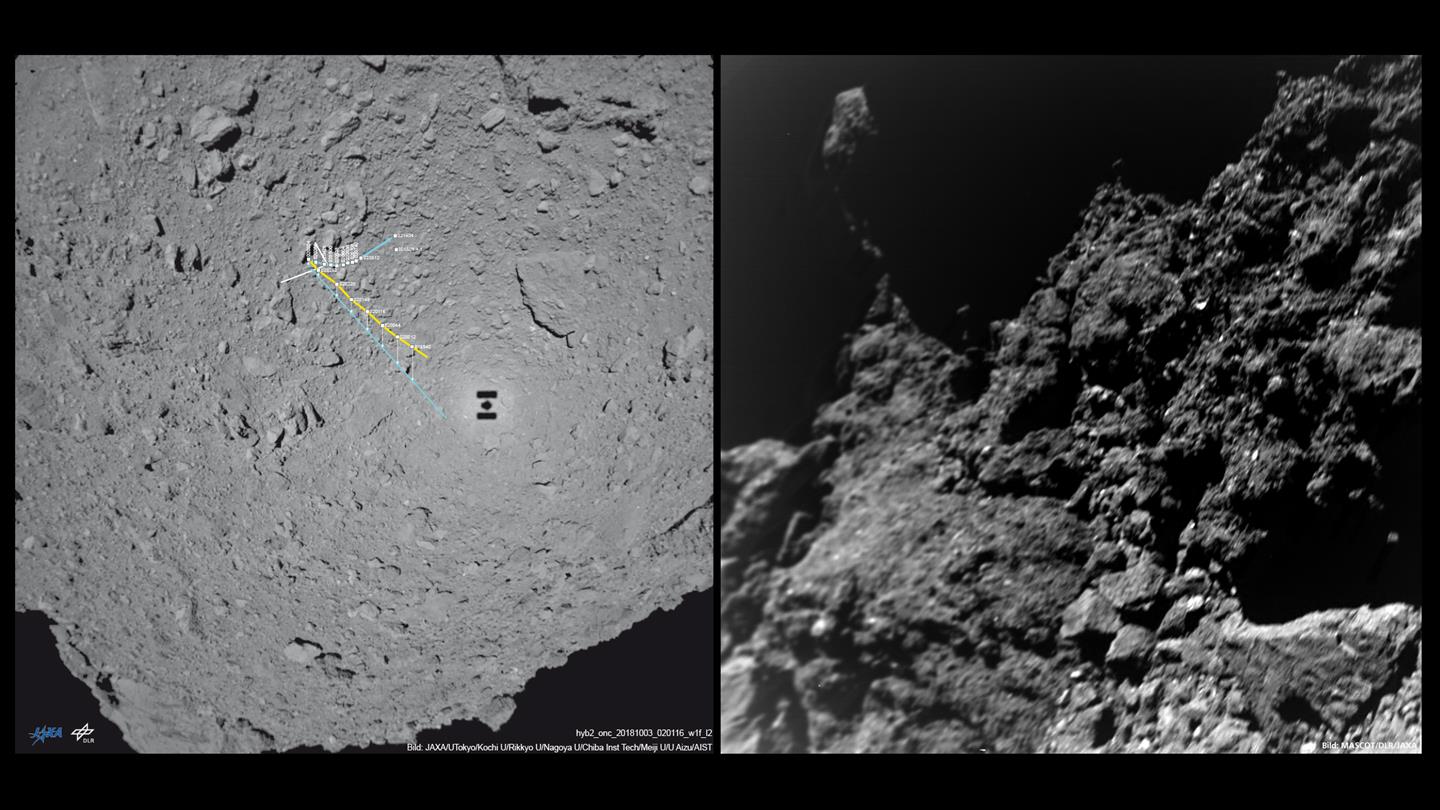'Crazy' Rocky Surface of Asteroid Ryugu Revealed in MASCOT Lander Images
BERLIN — A shoebox-sized European space robot turned up a few surprises when it hopped around on an asteroid last week.
In newly released images, the surface of the asteroid Ryugu is "even crazier" than expected, said Ralf Jaumann of the German Aerospace Center's (DLR) Institute of Planetary Research, the scientific director of the MASCOT mission. "Everything is covered in rough blocks and strewn with boulders," he added in an image release.
With a diameter of about 3,000 feet (900 meters), Ryugu is one of 17,000 known near-Earth asteroids, and it's made up of some of the most primordial material in the solar system. Studying the space rock's properties and composition could help scientists understand the building blocks of planet formation. [These Asteroid Ryugu Photos from the MASCOT Landing are Amazing]
While researchers will be poring over the new data from the DLR-made MASCOT lander in the coming weeks and months, they're already starting to piece together a clearer picture of the asteroid.

Sticking the landing
In the early hours of Oct. 3, about 185 million miles (300 million kilometers) from Earth, MASCOT was deployed from Hayabusa2, the mother ship made by the Japan Aerospace Exploration Agency (JAXA). [Japan's Hayabusa2 Asteroid Ryugu Sample-Return Mission in Pictures]
"There was a possibility that MASCOT might get stuck in its holding cavity [on Hayabusa2]," Tra-Mi Ho, MASCOT project manager from the DLR, told Space.com during a meeting with reporters in Berlin on Friday (Oct. 12). "When we got the signal that it separated, we were very happy."
MASCOT then made a 6-minute free fall from a height of 167 feet (51 m) to the asteroid's southern hemisphere. After analyzing data from the descent, mission researchers think the robot hit a large boulder and bounced several times before eventually landing on its back like a turtle with its camera pointed at the sky — not an ideal position for collecting data. MASCOT has no wheels or propulsion system, but thanks to its swinging arm, the lander was able to right itself with a little push.
Get the Space.com Newsletter
Breaking space news, the latest updates on rocket launches, skywatching events and more!
"We also were very surprised that the area of bouncing was much more constrained than it was, based on our simulations," Ho said. The gravity on Ryugu is one-66,500th of Earth's, so even a tiny push off the surface is enough to send the lander hopping (or potentially floating away from the asteroid).

The view from 'Wonderland'
MASCOT's battery life lasted a little longer than expected, allowing the robot to collect data over 17 hours and 7 minutes, or more than two asteroid days, at the landing site dubbed "Alice's Wonderland." The lander was carrying four experiments: the MASCAM camera and a radiometer, both made by the DLR; a magnetometer built by the Technical University of Braunschweig; and an infrared spectrometer made by the French space agency, CNES.
MASCAM produced about 66 images with useful scientific content, Nicole Schmitz, a DLR researcher with MASCAM, told Space.com. Pointing to boulders in some of the images, she said, "It's very remarkable how big some of them are."
"The appearance of the surface is extremely surprising, because we have seen on other bodies in the solar system that there is also lots of dust and smooth parts of the surface," Schmitz added. "We don't really see any smooth parts on the asteroid so far. … We will still have to put together what it all means."

While the surface of the asteroid appears to be a ghostly gray in the images released by the DLR, its actual color is quite dark.
"The asteroid is extremely dark, close to black," Schmitz said. "When you see these images, we enhanced the illumination, because otherwise you would see nothing."
Hans-Ulrich Auster, a researcher at TU-Braunschweig, said magnetometer measurements indicated that the asteroid has a weak magnetic field and MASCOT's landing behavior offered clues about the stiffness of the asteroid.
"We saw here that 90 percent of the energy was lost [during landing] so that might be an indication that the surface is not as hard as stone," Auster said. "On the other hand, we can see it's not as soft as a comet."
Auster noted that the European Space Agency's Philae lander encountered a surface like cigarette ash when it was deployed to the surface of a comet in 2014. But that wasn't the case on Ryugu. [Japan's Hayabusa2 Asteroid Ryugu Sample-Return Mission in Pictures]

Most populous asteroid
The landing came less than two weeks after Hayabusa2 deployed two other tiny hopping rovers, the Japanese-built MINERVA-II1A and MINERVA-II1B.
"With MINERVA and MASCOT, you have three landers for the first time landing on an asteroid and even jumping across the surface performing several kinds of experiments on quite distant regions, which gives you a more global context for the characteristics of the asteroid," Ho said. "Definitely, it's the most populated asteroid in space history."
The $150 million Hayabusa2 mission launched into space in December 2014. The spacecraft is carrying yet another small rover, MINERVA-II2, which is scheduled to be deployed to Ryugu's surface next year. Hayabusa2 is also slated to collect a sample of Ryugu rock and send it back to Earth at the end of 2020 so that the pristine cosmic material can be analyzed by scientists directly.
Follow Megan Gannon @meganigannon. Follow us on Twitter @Spacedotcom and on Facebook. Original article on Space.com.
Join our Space Forums to keep talking space on the latest missions, night sky and more! And if you have a news tip, correction or comment, let us know at: community@space.com.

Megan has been writing for Live Science and Space.com since 2012. Her interests range from archaeology to space exploration, and she has a bachelor's degree in English and art history from New York University. Megan spent two years as a reporter on the national desk at NewsCore. She has watched dinosaur auctions, witnessed rocket launches, licked ancient pottery sherds in Cyprus and flown in zero gravity on a Zero Gravity Corp. to follow students sparking weightless fires for science. Follow her on Twitter for her latest project.









